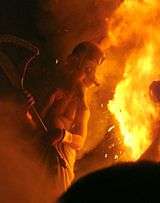Cremà

The cremà (origin from the Valencian word cremà, which means "burning") is the act of setting fire to Falla monuments made from materials such as cardboard and wood during the festivities of various locations of Valencia, Spain. These monuments are called fallas or bonfires, depending on the place they are held. Fallas are burnt in Valencia and the Bonfires of Saint John are held in Alicante. The celebration ends with the burning of the monuments.
The cremà of the fallas is held on the night of Saint Joseph's Day, March 19. It consists in burning the monuments erected on the Valencian streets on March 15. The ceremony is preceded by fireworks which are lit by the commission "fallera mayor". Firstly, around 10 p.m., the child monument is set on fire and at 10:30 p.m. the prize winning falla of the special section is also set on fire. After, the main monument is burnt at midnight and after half an hour the 1st prize winner of the special section in this category is burnt too. Finally, at 1a.m. the fallas monument, which doesn't take part in the competition, is set on fire in the Town Hall Square
The cremà also takes place for the Bonfires of Saint John, which are lit in Alicante (Spain). It takes place on June 24 and 25 by night, one day after St. John's Eve. The participants usually cry out to the firemen that supervise the fire to be soaked because of the summer heat and the fire; when they start doing it with hoses begins the Banyà. In Alicante the cremà starts at midnight from the castle of Santa Bárbara and it continues until 4a.m.
In both Fallas and Hogueras it is usual to burn the monument with a traca (a wick lined with firecrackers that explode quickly one after another) and lately with fireworks too. Then the monument is set on fire to the beat of folk songs. In order to prevent all the monuments burning down at the same time, they are usually set on fire at different hours, depending on the prize they have won.
See also
External links
| Wikimedia Commons has media related to La cremà. |
- Fallas Council
- St Jogn's Eve, Alicante
- Explanation of the Cremà on Distrito Fallas
- Fallas currently on the dynamic website Fallas de Valencia
- Cremà on YouTube.